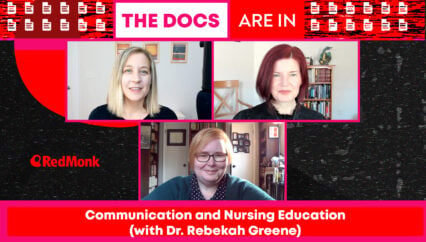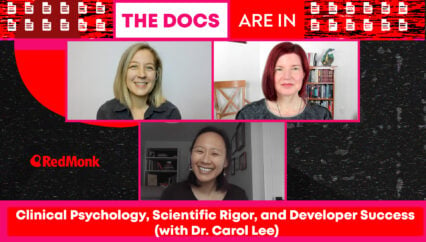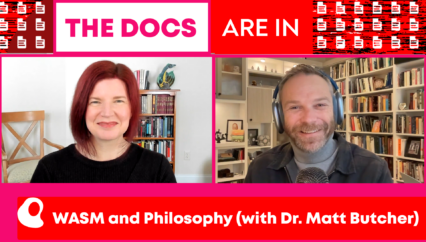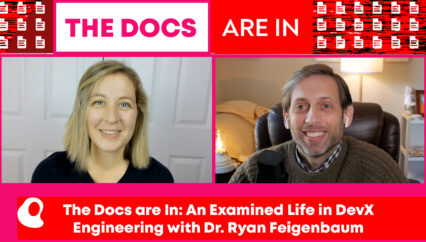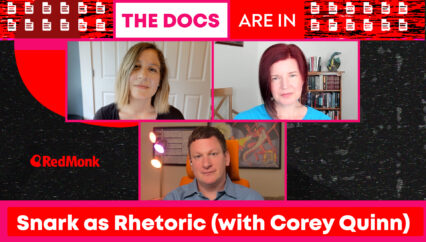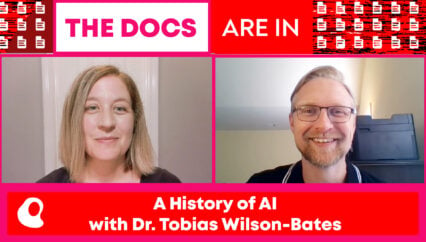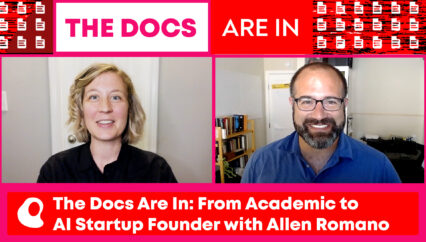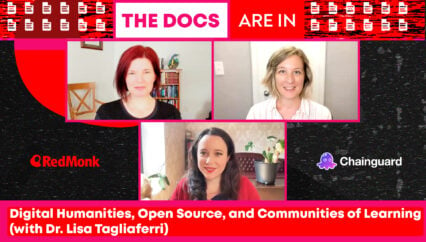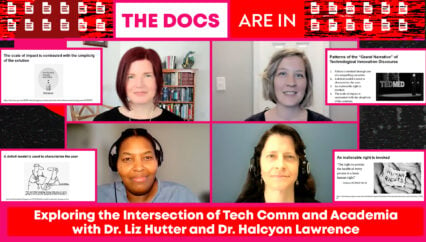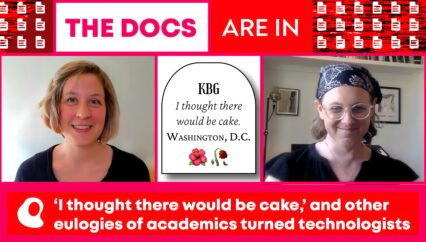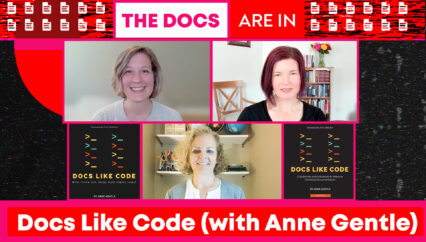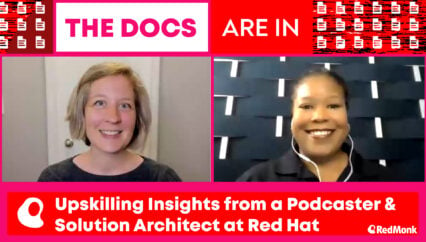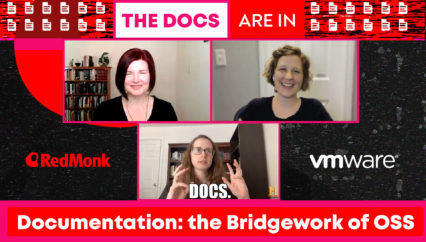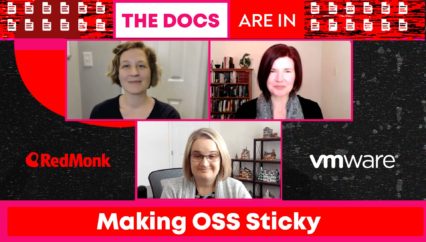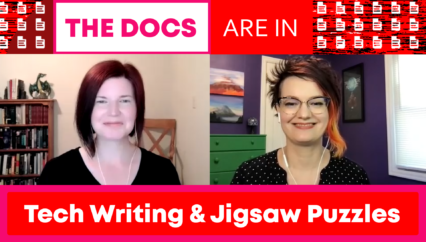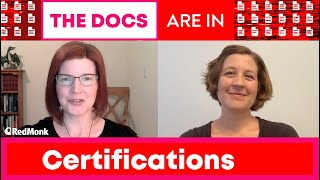In The Taylor Swift Episode of The Docs Are In, Kelly speaks with Dr. Casey Alane Wilson: a former Georgia Tech colleague and current Assistant Professor of English at Francis Marion University (and also, clearly, a Swiftie) about her first-year English course on “Taylor Swift as Text”. If you’ve spent hours on a virtual queue for Eras Tour tickets, pondered the literary references in Swift’s songs, wondered why Swift is re-releasing her albums, or just want to hear how LLMs are affecting university classrooms, this episode is for you.
More on Kelly’s CS tech/junior design course series and what it was like inside the CS Tech Comm classroom.
Rather listen to this conversation as a podcast?
Transcript
Kelly Fitzpatrick: Hello and welcome. I’m Kelly Fitzpatrick with RedMonk. This is The Docs Are In, where we sometimes talk about documentation and tech comm and sometimes talk to folks with doctorates and sometimes both. This is the Taylor Swift episode. And you heard right: the Taylor Swift episode, not Swift the Language or Jonathan Swift, the Gulliver’s Travels author or anything like that. And with me today is Dr. Casey Alane Wilson. Casey, can you please tell us a little bit about who you are and what you do?
Casey Alane Wilson: Absolutely. So I am an assistant professor at Francis Marion University in Florence, South Carolina. I teach a lot of different things that we’ll talk about as this goes on. You know, business communication, technical communication, which is (we’ll get into this) how we kind of know each other, but also a lot of composition and first year writing, literature courses, various things. And my academic research background is primarily in young adult and children’s literature and digital media and popular culture, which is kind of where we get into today’s Taylor Swift episode.
Kelly: Very cool. Thank you so much for joining us today. And you alluded to this a bit before, but as with my current RedMonk colleague, Dr. Kate Holterhoff, you and I met when we were both doing postdoctoral fellowships at Georgia Tech. Where in year one we were both teaching in the CS tech/junior design course series, which I’ve written about a lot and we’ll put some links to that in the show notes for those of you who really, really want to know about it. However, in addition to teaching courses on tech comm and business and all that other stuff you do like, as you noted, you have a really super interesting background, both academically and creatively. Can you speak a bit about how your areas of interest got you to a place where you you could just walk up and be like, I’m going to teach a university course on Taylor Swift?
Casey: So, I am a little bit of a person who academically has always done a little bit of everything. I’m the jack of all trades in most departments that I have been in because I like a little bit of everything. I hop around, I have the hyper focuses that take me place to place. So my primary area (like I said is in children’s and young adult literature and digital media and pop culture which sound like a big range of things and it is. But I often really like seeing how they all mold together. What’s happening with, you know, what used to be new media. Now I’ve updated it to digital media because it’s not so new anymore.
Kelly: It is not so new anymore. That is correct.
Casey: And how youth culture and especially teenage culture is particularly interesting. You know, I do some writing on the side. So there’s all this stuff that I am interested in. And along with that, I am someone who I have been aware of and known about and listened to Taylor Swift from the very beginning, from when she dropped “Tim McGraw” as that first single. I have been kind of following her career at different levels of enthusiasm over the years because she’s had a long career and that waxes and wanes as with anything. And so, here at Francis Marion, we have a version of our introduction to literature course that is themed where professors can pitch different topics. And at one of the faculty meetings, one of my colleagues who collects these themes said, “send us weird stuff,” And I was like, “You’re going to regret that.” And I sent him a pitch.
Kelly: Or not. They’re not going to regret it at all.
Casey: But yeah, I sent a pitch for a class called “Taylor Swift as Text” and so that went through the committee process and got approved. And I’ve taught it I think, twice as that version of the class. And I am teaching it again this summer in a slightly different context.
Kelly: And my understanding is that the section of the class this summer, you were explicitly requested to teach it. So it’s by request you are teaching this.
Casey: Yeah, it was brought to me. It’s a class that has been put in place to try and reach students who need to meet certain criteria by fall. And it was something that the people who were putting it together thought that the Taylor Swift class could be a fun class for them to potentially take. And so I said, yeah, because why not?
Kelly: Because why would you not want to teach your Taylor Swift as Text class during the same season when you are actually going to go see her Eras tour.
Casey: Yes because that did overlap went to see the Eras tour in the middle of teaching this class so this summer so.
Kelly: Which is I think great. So you’ve spoken a little bit about how previous sections of the class have been a little different than what you’re doing now. Can you tell us about either one, like what you have done with the course, what you’re doing with it now?
Casey: It’s largely pretty similar, even this version that’s set up a little bit differently. So the way I’ve designed it and there are other Taylor Swift classes out there, there are other people who teach them and teach them from different perspectives and different angles. Because I was coming at this from an introduction to literature perspective, the way that I have set up this class is that I am doing it through the lens of the references that Taylor Swift makes in her music to literature, because there’s a lot of them. Taylor Swift has from pretty early on, not necessarily a ton on her first couple albums, but like pretty early on, she starts making references to pop culture and other artists, like her first single is about Tim McGraw, right? So she’s always had this kind of intertextuality to it. But she also very specifically has referenced a lot of literature and a lot of classical canonical literature. She references–multiple times–she references The Great Gatsby, she references Romeo and Juliet in one of her first big hit singles, “Love Story”.
Kelly: That’s the one that pops up in my head when you talk about literary references; I’m like, oh, you have Shakespeare.
Casey: Yeah. She references Shakespeare. That song and another song “The New Romantics” also both reference The Scarlet Letter. There’s references to Emily Dickinson and Robert Frost, and she has a song called “The Lakes” about the Lake Poets, which is, you know, a group of poets who helped to establish the whole romantic movement, which really changed literature and the world in our culture, in Western society in a lot of ways. And so what we do in the class is we read the texts that she references, and then we study them for their own merit and for their own sake. But then we also put them in conversation with why are these the texts she is referencing? Why are these the stories that are speaking to her and that she wants to use and transform in her own music in that way?
Kelly: One of the fun facts I learned while I was studying up on this– because I am not a Taylor Swift expert by any means–was her album, Reputation–and this is from a Wikipedia article. So it could be completely wrong. I didn’t do hardcore research on this.
Casey: The Swifties aren’t going to allow misinformation to stand on Wikipedia for long, so I think you’re probably okay.
Kelly: That is good. But the thing that really excited me was that Game of Thrones helped inspire that entire album and specifically Arya Stark, that character inspired some of the songs on there. And I was like, okay welcome to my world.
Casey: There’s definitely crossover there. Yeah, it’s really interesting because she does so much with the source materials that she chooses. Sometimes it is just a very simple reference, right? The “You were Romeo. I was the scarlet letter,” in “Love Story” is something that she got critiqued a lot for at the start. When that came out, people were like Romeo and Juliet isn’t a love story. It ends with both of them dying. And yes, it does. But also, she’s not the only one in our culture that has forgotten about the ending of that. Romeo and Juliet are constantly talked about as a paragon of love and romance. And that’s something that I have my students grapple with: what does it mean that we can focus on their love story and not their tragic deaths at the end? But even aside from that, she has some of her uses of The Great Gatsby more recently on the album Evermore in the song “Happiness”. It’s this really lovely song about recognizing when a relationship is ending and that you can remember that there were good things about the relationship and that it still had to end. And also that in the future you will be happy again. Right. And so this kind of whole refrain of all of these pieces and there’s this echo of, what you want from me now is the green light of forgiveness, which is a reference to this green light that appears as a recurring motif in The Great Gatsby.
Casey: But it’s such an interesting twist on it because it’s a much more. For Gatsby it was such a sign of obsession. And this is a sign of growth and change, which is a really interesting way to spin that idea. And in the same song, she references Daisy’s very famous (quote) “All I want for my daughter is to be a beautiful little fool.” And in this song, there’s a moment where the narrator kind of says that whoever this ex-lover ends up with next, she hopes she’ll be a beautiful fool who takes my spot next to you and then immediately, though, brings it back. No, I didn’t mean that, you know, And this idea of. Nope, I’m trying to be better than that. That’s not what I want. Right? Which is a kind of growth that Daisy never has in the book. Right? For Daisy, that’s all she is, is, and all she wants is in that space. And so it’s really interesting when you get into some of the nuances of those things of how she’s using them. And I don’t always get to even get into that level of nuance with my students. But it’s really fun to see those different levels of reference in her work.
Kelly: And it’s not just Taylor Swift as text, but all of the, as you said, intertextual references, which is a word we don’t use in the tech industry that often. But it’s a really great import from literary studies, how texts interact.
Casey: Just the idea that, and I think that that’s something that I find so interesting about because I’ve been thinking about it a lot in the context of talking to you about it on this series,is that idea of intertextuality, as you say, is not necessarily something that we think about in tech circles of, how are all these references happening to one another. But still, that act of relying on each other and what other people have said and read and done and built beforehand to create what you’re creating is very much there. Right? And so the act is present, even if the larger conversation is maybe not using those same words.
Kelly: Very much. And if you wanted to, you could make the argument that some of the best technical documentation we see is intertextual and bringing in all these different formats. So the Taylor Swift episode definitely belongs in this series is where I’ll leave it with.
Kelly: So I alluded to this a bit before, but so this summer it’s 2023. There’s been a lot of buzz around Taylor Swift and the Eras tour.
Casey: Yes.
Kelly: As an aunt to multiple nieces who loved Taylor Swift, one of which put together an entire comprehensive slideshow to educate our family about Taylor Swift.
Casey: It’s very good. I have to say, I was telling Kelly before this that my slideshow that I put together for my students is not nearly as detailed and comprehensive as the one her niece made.
Kelly: Yeah, and she’s in high school, so I hope she doesn’t become an academic. I hope she finds some other thing to do because academia has its own kind of drama. But I’m like you could do this for a living already right now.
Casey: She’s got some potential in there for sure.
Kelly: But I of course was recruited to help attempt to get tickets for the tour. So I witnessed firsthand the experience of dealing with some of the technical issues that folks ran into where things were just falling down, queues were falling down. And one of the things that’s really fascinating is I have heard stories of Swifties. That’s Taylor Swift fans, right? I have that right?
Casey: That is the term.
Kelly: All right. So I’ve heard stories of Swifties actually reading through stack traces and error messages that they’ve gotten to figure out what technologies are involved. And we will not name names on this show like. But oh my goodness, you managed to get tickets. I failed–someone else in my family managed to come through with tickets–but you managed to get tickets, you managed to get through that process. You went to a show. What was the experience like? Has that changed how you teach? Were your students jealous? Like, where does that fit into Taylor Swift as Text?
Casey: So there’s a lot of things to it. So the thing that’s really funny is that I’m in South Carolina. Swift did not put on a show less than a four hour drive away. The closest one was Atlanta. So when I was looking for tickets, I decided I was going to look for tickets in Detroit because that’s where I have a friend who is also a big Taylor Swift fan. But I wasn’t sure if I was going to be able to do it because again, I teach and tickets tend to go on sale at 10 a.m. local time situation. But what ended up happening was through sheer coincidence and happenstance (I did not plan for this in any way), the day that the tickets went on sale was the day I was teaching the Taylor Swift text class during the class period. The class period starts at 9:55. The tickets went on sale at 10:00 while I was already scheduled to screen them, The Hunger Games. And so it felt honestly pedagogically inappropriate to not try and get tickets as they were watching The Hunger Games. So I sat there and I sat in my queue and I was in that queue for like five hours. I was home, off campus at home, done teaching for the day before, finally got my tickets. And I have always said that it was because I wasn’t like, “I have to get tickets.” I feel that’s part of what made it possible for me to get tickets. I don’t know.
Casey: So when it was happening, there was a lot of conversation, as you said, people were looking into the code, trying to figure out, like they were saying, if you open up the page inspector and you go to here, you can see exactly how many people are in front of you in the queue and all of this different stuff. And that was spreading through a really interesting network of largely for me, TikTok, TikTok creators who were making these videos and sharing and spreading this information. And that’s part of a larger–trend isn’t even necessarily the right word–focus or obsession, let’s say, of Taylor Swift fans, which is that she has always left these like little Easter eggs and clues and things for fans to decode. And when she was younger, it was a lot of like the liner notes for her CDs (if we remember both of those things) would sometimes have in the lyrics or in the notes, they’d have random capital letters, and if you put them together, it would spell a secret message. And that has since spiraled into people literally tracking specifically what colors each of her nails are painted on each show of the tour to see if there are any changes and if those changes might have any secret meaning. And that’s the pretty restrained version of some of the things that they study and figure out and try and figure out. There’s a lot of numerology, and can we make things add up to 13 because that’s her favorite number and all of this stuff.
Kelly: I knew that from the slide show.
Casey: Yes, very important information. It’s the day she was born, December 13th. So it’s her favorite number. But yeah, so it’s really interesting because there was already this tendency of Taylor Swift fans to really get into the minutiae and the details and the hidden meanings and the things that you can’t see on the surface. And then all it did was shift about three degrees when that came out to be, “well, let’s get into the code” because it’s the same thing. It’s the same obsessiveness. It’s the same attention to detail and making connections. It’s just in a slightly different direction. So yeah, that was definitely part of it.
Casey: The show itself and the tour was great. It was long. She puts on a really long show. She plays for three hours and 15 minutes or so, which is a lot. There were a lot of people there. One of the things that happened is fans started making friendship bracelets that they would trade with each other before a show, which was really fun. So there’s a lot of stuff there. But it was really interesting because I was attending very much from a dual perspective, right? I was there as a fan, but I’m also there as someone with this professional interest in all of this. And to your point, your question about if students were jealous: yeah, there were definitely some students who were really pulling for me to get tickets. Students who had been really jealous when they found out I got tickets, different things like that. But what’s really interesting is actually that the class is not typically full of big Taylor Swift fans. And so. There are a lot of people. There are a decent amount, usually a couple that are big fans. There are a few that know some of her music, and then there are the ones who either don’t know her music at all or didn’t even know that this was a class about Taylor Swift when they signed up for it.
Kelly: They’re like “When do we read Gulliver’s Travels? Like, when is it happening?”
Casey: So it ends up being a really fun balance of different levels of interest, different levels of engagement. I don’t know if I fully answered all of your questions in there, but, but yeah, it’s fascinating because every semester that I’ve taught this class so far, because she is such an active producer, so, so prolific in producing things, there has been something significant happening in each semester. So the first time I taught it, the re-release of her album Red was happening during that time with the drop of the ten minute version of “All Too Well”. And then there was Midnights and the Eras tour release when I taught it the second time. And then this semester it’s of course the actual tour itself. And so it’s been really fun to always have something to point to that’s developing or changing as it’s happening.
Kelly: Yeah. And you and I talked a bit about this before we started filming, but the re-release of albums with Taylor Swift is like, talk about intellectual property and things that are licensed. Can you just explain that situation briefly for folks out there who do not already know it?
Casey: No, absolutely. No. This is actually one of the most interesting things that Taylor Swift has been doing recently, because it’s interesting both musically and as a fan. But it’s also really interesting, as you say, from this business and intellectual property perspective. So when Taylor Swift started out as an artist, she was a teenager and she signed with Big Machine Records, which was a new record label out of Nashville. And she became (you will be shocked to learn) their anchor artist. There are estimates that I’ve seen that upwards of 80% of their revenue and profits came because of Taylor Swift by the time you know that. And that was with Big Machine being a fairly successful label and having a lot of other very successful artists on it. But when she signed that contract, part of the contract was that Big Machine would own the masters. In music, there are two primary forms of ownership rights. There are publishing rights and masters rights. Publishing rights are the rights to the song, and those are usually held by the song writers. Taylor Swift is the primary songwriter on basically all of her songs that she’s recorded, other than like a couple covers here and there. And so she’s always had the publishing rights, which means she can perform them when she likes and all of that.
Casey: What she doesn’t have is the masters. And so for the first six albums, which was the length of that contract was for six albums, Big Machine owns the right to the recording itself. And so when it comes to things like licensing or being played on the radio, for what extent that still happens or, you know, you know, streaming, right, all of these different things. Big Machine had control over that portion of it. But what’s happened is since she signed with a new label, she now owns the masters for all of the albums she’s released since then. So she’s released a number of albums since then. And that’s all well and good, but the sticking point came when the original owner of Big Machine Records sold the catalog, including Swift’s music, to a venture capitalist group that is owned (or has a major stake in it, let’s say I don’t want to necessarily over speak for the situation) by a person that Swift is not a fan of. She does not like this person. She has never worked well with him, does not want him to own her music. To hear Swift tell it, there has never been a necessarily a fair option presented to her to buy back her own music. And so what she has done instead is she has set out on a project of rerecording those first six albums so that she can re-release them and essentially make the original versions worthless. She records them very closely to what they were at the time. Very minor changes that, you know, casual fans would not be able to pick up the difference at all.
Kelly: I would not. I would not know the difference.
Casey: Absolutely. You know, only the people who have memorized every single inflection on every single note really will notice most of the time. But even those fans are mostly on board with this idea because they want Taylor to have the ownership of her music. And so what’s ended up happening is she has started re-releasing those albums. She’s re-released her second album Fearless, and then she re-released Red and then in just a couple of weeks on July 7th, 2023. She’s going to re-release Speak Now. And each time she does that, she also releases them with additional songs. So it’s the rerecorded version of the original album, as well as songs that were potentially going to be on that album when it was first recorded. But that, especially at the time, things like technology limitations were a big part. There’s a reason that most albums during the rise of CDs were 10 to 13 songs long, and it’s because because that’s what can fit on a CD. And so a lot of songs that maybe would have made the album if that was not the limitation, she is re-releasing it along with that. So that even for the fans who already have the original versions, there is a motivation to want these newer versions as well. And it has worked remarkably well. This is the kind of project that a less dedicated and an engaged fan base might write it off. But she has had remarkable success with her fans fully embracing this and the original versions of the albums. I’ve seen people make really cool trackers of like the play counts of these different albums and the way that as soon as the re-release comes out, the original one just disappears. It’s genuinely kind of fascinating to watch.
Kelly: So the data tracking element of being a Swiftie.
Casey: Oh, that’s an intense part of it, too. They really track every single, every single thing that they can to try and better understand what’s happening.
Kelly: I look forward to the new slideshow from my niece that is going to give me all of this data in probably PowerPoint form, I assume.
Kelly: So I have to ask and you don’t have to answer. But AI and specifically LLM-driven technology like ChatGPT and Google Bard have been disrupting the tech industry in so, so many interesting ways. But when I talk to colleagues like yourself who are still in the classroom, it seems that you are dealing with a level of disruption that the rest of us are maybe not having, having to deal with. We have mutual colleagues who have been like, I have had to deal with so many honor code violations or honor committee meetings just this past spring semester. How have you seen this play out in your classes?
Casey: Yeah. So I take my students’ privacy very seriously. So I won’t give any specific examples of instances that I’ve seen. But I will say that, yes, this has definitely been a thing. What we’ve been encountering in the academic space is we are in a transitional period between these tools being introduced and effective strategies being in place for how to work with or handle these tools. And so we’re in this kind of no man’s land of trying to figure it out the best we can as we go. And there are some people who are on the side of we can’t touch it at all, we can’t interact with it at all. And there are some people who are on the we’ve got to learn to work with it kind of thing. And so I have definitely had a few students submit things in recent semesters that I have had reason to think were written by or were predominantly written by something like ChatGPT. And one of the things that I have found most interesting about it is that. It’s rarely for me the issue of quote unquote “quality” in terms of they’re generally well written. Sometimes they make up their sources and sometimes the things they say aren’t true. But it’s generally, you know, they’re easy to read. They’re fairly convincing. They sound nothing like my students. And that is one of the things that I notice is that we are definitely seeing when I see them. Part of what stands out to me is this is not the student I’ve been talking to all semester. This is not the student whose work I’ve been reading all semester, not because they aren’t capable of writing really well thought out things and really “clean” writing, quote unquote. But just because it doesn’t have the voice, it doesn’t have the personality. And so, I am someone who, I tend to, like I said, I study digital and digital media. I tend to try not to approach it from a perspective of assuming that all technology changes are going to be bad. Right. I try to kind of come at it from, well, what is this doing? What is it that. I will say I’ve been hesitant to engage with something like ChatGPT myself, largely because there have been so many ethical concerns about how the data has been obtained for these various models that I find myself reluctant for now to provide them with more data to work off of.
Casey: That being said, I do think that I have seen a lot of remarkably smart people bringing them into the classroom in ways of saying, okay, let’s use this, let’s talk about it like and having students generate responses and look at them and actually see. This is maybe not as good as I could have done. Right? And to find the flaws and the problems and to understand it. And so I think that right now we are definitely in like I said, a transitional space. It’s something where, and we’ve been in that space for a long time. I think that we’ve been in this space in different ways in the past that, you know, the pandemic really forced a lot of people to start using online learning management systems that had never used them before. And that’s a good thing. But it also means that I think some faculty who are still learning how to deal with that are now grappling with this question of what do we do about something like ChatGPT when it shows up in our class?
Kelly: Here is an avalanche to fall on top of your existing concerns about dealing with your new LMS.
Casey: Yeah, and I have seen a lot of conversation around whether this means we’re going to start –I don’t want to use the word regressing because I don’t think that that’s inherently what it is–but if we’re going to see a return to more in-class writing of sit down with your pen and paper and do this in front of me so that I know you did it, which has its pros, but it also has its cons. There’s a lot of questions to be had there about accessibility.
Kelly: Yes
Casey: And how much that shuts down tools that students need to succeed. And so, there’s a lot going on. I think that in my experience thus far, a lot of the students who go to those tools rather than trying to write for themselves, are not necessarily doing it because they’re convinced they can get away with it,but for the same reason that students do anything that violates any sort of honor code, which is: they’re tired, they’re exhausted. They have other things in their life.
Kelly: They’re working three jobs and they have to get their essay in.
Casey: Yeah, this seems like the thing that can save them time. And that’s not necessarily an excuse. And it’s not always great, but it is a reality, right? We see a lot of articles. There was one recently that like to make fun of students whose grandparents suddenly died during the last week of the semester. And it’s like, well, yeah, but sometimes their grandparents do die. They are at that age where that is a thing that happens. And also if they are lying to you about it. That means there’s bigger problems at hand than the lie itself. And I think that’s kind of where I am with a lot of the ChatGPT stuff. Most of my students want to do the work and they want to learn and they want to do it themselves. And if they find they can’t or don’t, it’s a question for me to explore as well, as much as it is a reason to punish them.
Kelly: That all makes sense and I am completely unsurprised that you bring that much empathy to your classroom and to your teaching practices. And also I have done so much schooling like I hope I never go back to school, but the fact that I won’t be in a classroom having to handwrite something and that some poor professor is going to have to try to read my handwriting is a great, great relief to me.
Casey: Listen, there’s a reason that online writing is easier and that ability to read it is not nothing. And it’s actually really interesting too, because there are other ways that you see those tools that we use show up even outside of instances where they like “shouldn’t” use them, quote unquote. Because, you know, one of the things I have noticed so much in the last five years or so is that a lot of students will leave a space between a word and the punctuation that they’re using. So they’ll end a sentence and there will be a space and then there will be a period or a comma in particular. And that’s such an indication of the technology they’re using to write the thing, of the way that those things get put in and some students will dictate, and that plays a role in it. Some of them, you know, don’t have the settings on to have it automatically fix it and all these different things. And it’s just, it’s such an interesting thing to be able to have been in this long enough to see the different trends and changes in student writing as not just a failure of education or a failure of the student, but as a change in technology and what that means for our writing processes.
Casey: And I think that that’s what we see with ChatGPT right, that that is going to be another one of these technologies that is going to change these conversations. It’s going to change how students write. And I don’t know what the answer is. I don’t know what that’s going to look like. There are, I’ve seen compelling arguments for both. We have to just make it one of the tools that we use in all of our steps. And also these systems are going to have a major collapse in the next few years and we won’t have to worry about them anymore. I’ve seen both arguments made compellingly, and I don’t know, I’m not the expert. And so I’m in a sit back and wait and see. And in the meantime. Give my students the benefit of doubt whenever I can. And think about what I need to be changing to make it work.
Kelly: So bringing things back to Taylor Swift, because this is the Taylor Swift episode. But thinking about especially her Eras tour as looking back at all her different phases and we just talked about the evolution of technologies and, even the current mode where she’s touring and performing. She’s putting out re-releases with new stuff and she’s putting out a collage or bricolage or a combination of things. You know, that definitely fits with my medievalism studies background, but also it definitely feels very kind of tech industry. In closing, a final question: do you have a favorite Era?
Casey: The problem is. I have memories with each of them. And so it’s hard to necessarily pick one specifically. And I think what I will say is that I think my favorite era or album is different than my favorites in general. But Lover is something that is very significant to me because it came out right as I bought my first house here, right as I was starting this job. And so I have such distinct memories of like I would have it playing as I was painting my house and doing all these different things. And so it’s one where I think there are songs I love better. Like I think “The Lakes” and “Ivy” on her Folklore and Evermore are remarkable tour de force songs that really show who she is as a songwriter. But there’s something so specific about Lover to me and kind of who I was when that album was coming out, that it’s always going to be a special one for me.
Kelly: I’m not surprised, but impressed that you had an answer to that question because, I don’t know if I do. But you did.
Casey: Not everyone has to and some people will find their Eras as time goes on. And one of the things that I always tell my students, too is that, I do not labor under the delusion that all of my students will walk away loving Taylor Swift, Right. No artist is for everybody. But I do think that most of them walk away finding her a little bit more interesting than they may be previously gave her credit for. And I think that that is a fair point to have around her that you don’t have to like her music. You don’t even have to like her. She has certainly done many a problematic thing over the years. But as a figure in the center of pop culture and technology and intellectual property and music, she’s kind of fascinating. And that’s what’s fun about it.
Kelly: No, no arguments from the analysts on the call at all for that. Well, Casey, this has been great. Thank you. Thank you so much for joining me today.
Casey: This was fun anytime. Whenever you need a Taylor Swift episode sequel, let me know.
Kelly: We’ll see. This may have to be a series within a series, but we’re at time. And with that, the docs are out.
